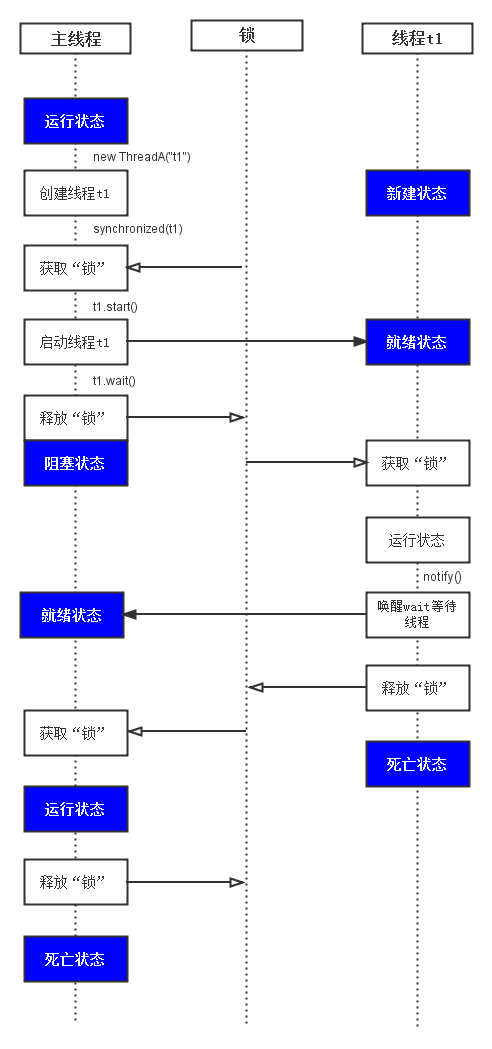-
代码:
try{ int a = 1; //1 int b = 1/ 0; //2 }catch(Exception e){ System.out.println(b);//3 }这段代码中虚拟机是否会对1跟2段代码进行重排序呢?如果2先于1执行,2抛出异常,代码将不会执行对
赋值的操作。答案是肯定的,即便存在之前所说风险,但
虚拟 机仍会对这两行代码进行重排序。但重排序的结果不会受到异常的影响,这是因为JIT在重排序时会在catch语句中插入相应的补偿代码(a = 1),这样做 的代价是会使的 catch里面的逻辑变得复杂,但是JIT优化原则是:尽可能地优化程序正常运行下的逻辑,哪怕以catch块逻辑变得复杂为代价。 -
代码:
class ThreadA extends Thread{ public ThreadA(String name) { super(name); } public void run() { synchronized (this) { System.out.println(Thread.currentThread().getName()+" call notify()"); // 唤醒当前的wait线程 //但其实在这段代码中,有没有notify()影响不大,因为只有两个线程(main、t1),t1在获取锁执行完这段代码后自然会释放掉锁资源,而处于 //等待队列的主线程也就会被唤醒得以继续执行 notify(); } } } public class TestJoin { public static void main(String[] args) { ThreadA t1 = new ThreadA("t1"); synchronized(t1) { try { // 启动“线程t1” System.out.println(Thread.currentThread().getName()+" start t1"); t1.start(); // 主线程等待t1通过notify()唤醒。 System.out.println(Thread.currentThread().getName()+" wait()"); //执行线程(主线程)释放锁资源(t1) t1.wait(); System.out.println(Thread.currentThread().getName()+" continue"); } catch (InterruptedException e) { e.printStackTrace(); } } } }- 代码解析:
首先,主线程获取到了对象t1的对象锁并启动线程t1,但是线程t1进入同步代码块试图获取对象t1的锁资源,此时t1的锁资源被主线程占有,因此线程t1并未
进入运行状态,而是在等待对象t1的锁资源。 之后主线程在执行到t1.wait()时将释放掉t1的对象锁资源进入阻塞状态。但是线程t1在获取到对象锁资源之后开始进入运行状态,进入run()方法的同步
代码块中,执行notify(),将主线程进行唤醒操作,主线程得以继续执行。from https://www.cnblogs.com/skywang12345/p/3479224.html 注意看评论
- 代码解析:
首先,主线程获取到了对象t1的对象锁并启动线程t1,但是线程t1进入同步代码块试图获取对象t1的锁资源,此时t1的锁资源被主线程占有,因此线程t1并未
-
代码:
public void testSeq() { Object obj = new Object(); Thread t1 = new Thread(() -> { synchronized (obj){ System.out.println("t1 possess the monitor"); try { obj.notifyAll(); } catch (Exception e) { e.printStackTrace(); } } }); Thread t2 = new Thread(() -> { synchronized (obj){ System.out.println("t2 possess the monitor"); try { Thread.sleep(3000); obj.notifyAll(); } catch (Exception e) { e.printStackTrace(); } } }); Thread t3 = new Thread(() -> { synchronized (obj){ System.out.println("t3 possess the monitor"); try { obj.notifyAll(); } catch (Exception e) { e.printStackTrace(); } } }); synchronized (obj){ try{ t1.start(); t2.start(); t3.start(); System.out.println("main"); obj.wait(); System.out.println("end"); }catch (Throwable e){ e.printStackTrace(); } } }- 解释:
上述代码运行中,main线程先获取到obj对象的锁资源,但随后执行wait()操作将锁资源释放掉,但当其他线程将锁资源释放时,main线程也不能马上
执行,仍要先获取到obj对象的锁资源才得以继续执行
- 解释:
上述代码运行中,main线程先获取到obj对象的锁资源,但随后执行wait()操作将锁资源释放掉,但当其他线程将锁资源释放时,main线程也不能马上
